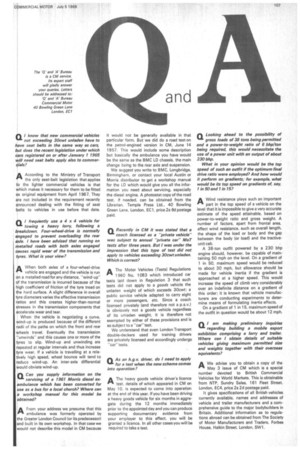n Looking ahead to the possibility of
Page 109

If you've noticed an error in this article please click here to report it so we can fix it.
gross loads of 38 tons being permitted and a power-to-weight ratio of 6 bhp/ton being required, this would necessitate the use of a power unit with an output of about 230 bhp.
What in your opinion would be the top speed of such an outfit if the optimum final drive ratio were employed? And how would it perform on gradients; for example, what would be its top speed on gradients of, say, 1 in 50 and 1 in 15?
AWind resistance plays such an important
part in the top speed of a vehicle on the level that it is impossible to give a very accurate estimate of the speed attainable, based on power-to-weight ratio and gross weight. A number of factors, apart from frontal area, affect wind resistance, such as overall length, the shape of the load or body and the gap between the body for load) and the tractiveunit cab.
A 38-ton outfit powered by a 230 bhp engine should, however, be capable of maintaining 50 mph on the level. On a gradient of 1 in 50, maximum speed would be reduced to about 30 mph, but allowance should be made for vehicle inertia if the gradient is approached at a higher speed. This would increase the speed of climb very considerably over an indefinite distance on a gradient of this order: it is known that vehicle manufacturers are conducting experiments to determine means of formulating inertia effects.
On a gradient of 1 in 15, maximum speed of the outfit in question would be about 12 mph.
























































































































































